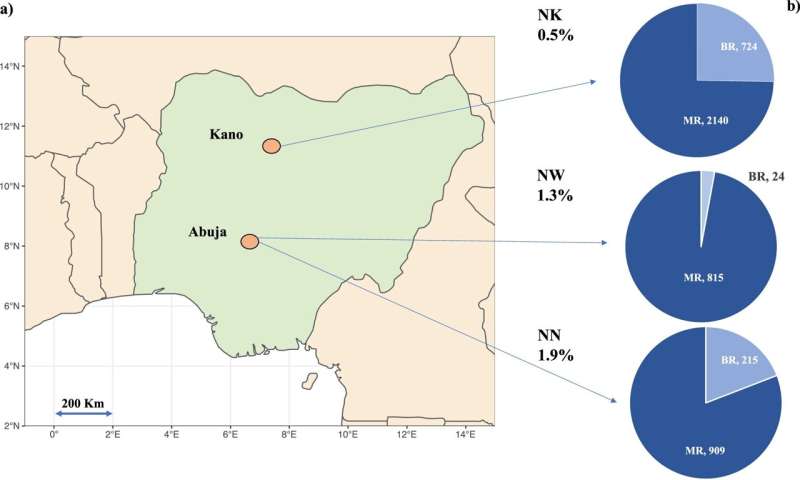This article has been reviewed according to Science X's editorial process and policies. Editors have highlighted the following attributes while ensuring the content's credibility:
fact-checked
peer-reviewed publication
trusted source
proofread
Colistin resistant bacteria found in mothers and newborn babies in Nigeria

Researchers from the Ineos Oxford Institute for Antimicrobial Research (IOI) and Cardiff University have found evidence that bacteria resistant to colistin, a last-resort antibiotic, were present in mothers and babies under a week old in Nigeria in 2016, despite limited clinical use of colistin at that time in the country. The findings have been published in Nature Communications.
The study was the largest screening of intestinal microbiota for colistin resistance in Nigeria, analyzing almost 5,000 samples from mothers and newborn babies across three hospitals. The researchers tested these for the presence of mobile colistin resistance (mcr) genes, which confer bacterial resistance to colistin.
Colistin is a broad-spectrum, 'last resort' antibiotic used to treat multidrug-resistant infections in humans. Despite its critical importance in human health, it used to be widely used in agriculture as an animal growth promoter.
"The identification of diverse mcr genes in newborn babies and mothers is concerning as it suggests the use of colistin in agriculture as opposed to in clinical settings may have maintained colistin resistance in the local community," said co-author, Dr Edward Portal, Ineos Oxford Institute for antimicrobial research (IOI), University of Oxford
In 2016, mcr genes were first discovered in E.coli bacteria from a pig being raised for meat on a farm in China. This led to a ban on colistin's agricultural usage in China in November 2016 and subsequently in several countries across Europe. However, although surveillance for colistin resistance has become widespread across Europe and North America, there has been a lack of information about the prevalence of colistin resistance in African countries.
To address this knowledge gap, the researchers retrospectively tested samples that had been collected between 2015 and 2016. At this time, it is thought that colistin usage in Nigerian hospitals was limited, although it may have been imported for use in agriculture and farming.
The researchers found a high diversity of mcr genes present in the samples, as well as in the species of Enterobacter carrying mcr genes. Enterobacter are gram-negative bacteria that have an outer membrane that acts as a barrier to antibiotics, making them highly resistant to many commonly used antibiotics.
Data from AMR surveillance suggests that high levels of colistin use continue in Southeast Asia and in some African countries. Research from the IOI recently found that multiple high-income countries still export colistin to low- and middle-income countries (such as Pakistan, Nigeria, and Bangladesh) for use in agriculture.
Dr. Portal said, "Samples were collected from mothers and their babies eight years ago when the usage of colistin to treat human infections was not common. Fast forward to 2024, colistin is increasingly used in medical and agricultural settings across Africa due to rising rates of multidrug-resistant infections that lack alternative options."
"This more regular use of colistin will likely rapidly select for resistant bacterial isolates and increase colistin resistance in Nigeria and further afield."
Targeted surveillance of colistin resistance is vital to understand how people are acquiring colistin-resistant bacteria. This is particularly important in vulnerable groups such as newborn babies. In 2018, one in five deaths from antimicrobial resistance were children under 5 years old, often from previously treatable infections.
Dr. Kenneth C. Iregbu, National Hospital Abuja, co-author of the paper, said, "The detection of colistin resistance genes in newborn babies in a hospital setting, where colistin use is very rare, suggests antibiotic-resistant bacteria is being passed mother to baby. The results from this study are concerning and underscore the need to understand the true route and mechanism of acquisition of such resistance genes in such an unexposed population."
More information: E. A. R. Portal et al, Characterisation of colistin resistance in Gram-negative microbiota of pregnant women and neonates in Nigeria, Nature Communications (2024). DOI: 10.1038/s41467-024-45673-6


















